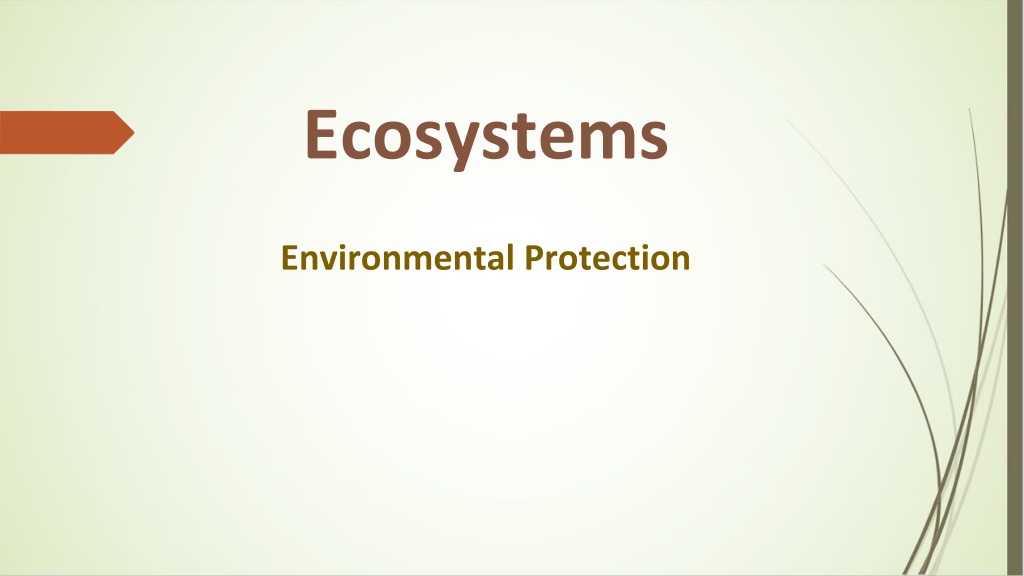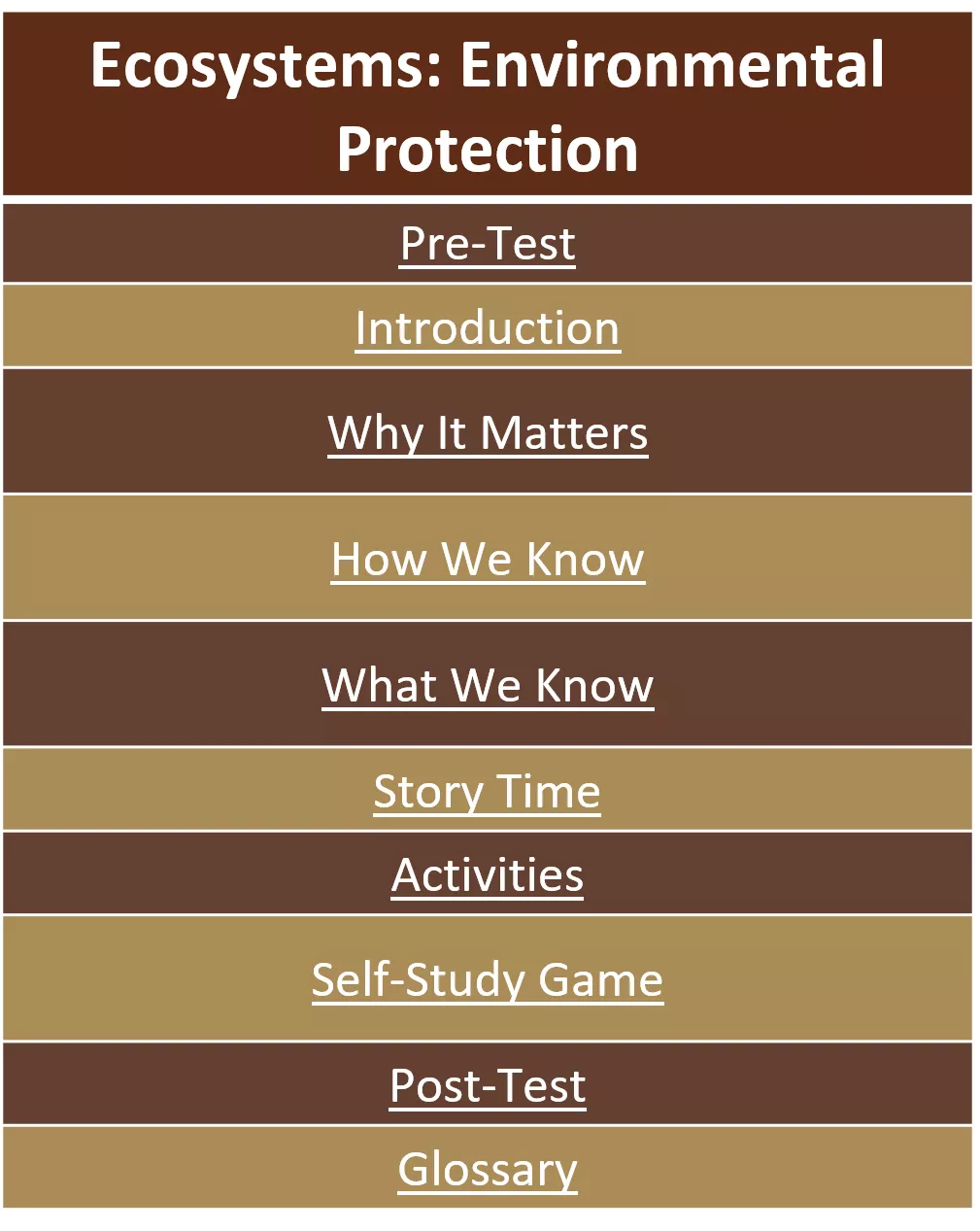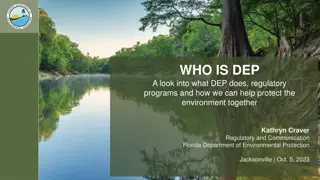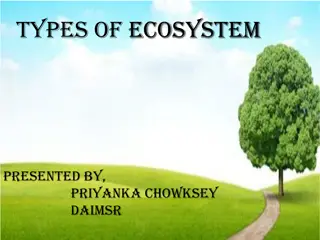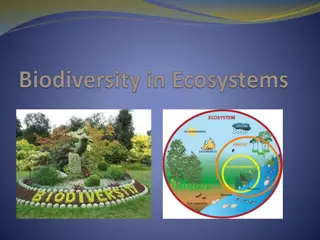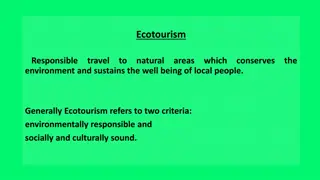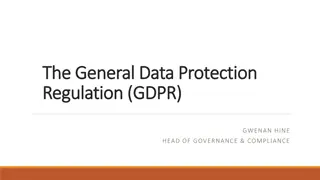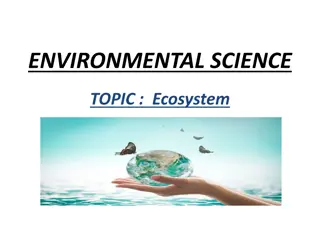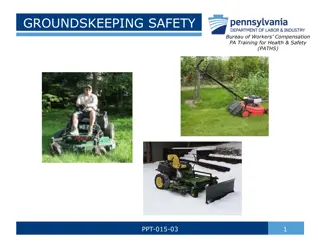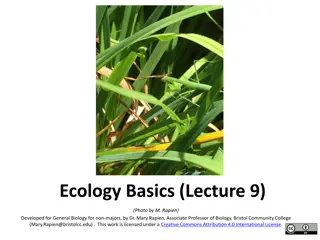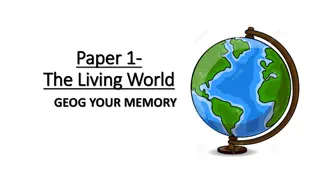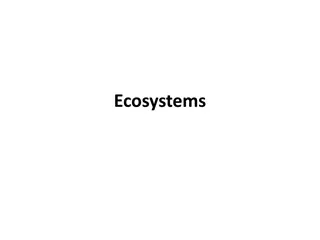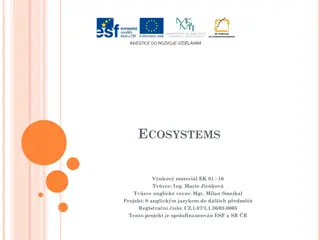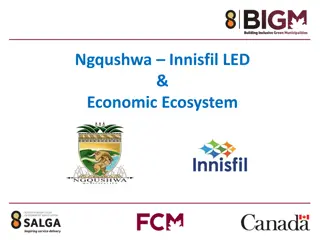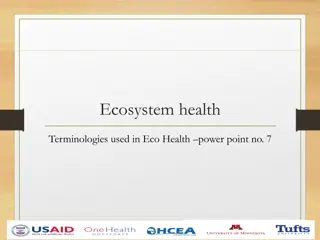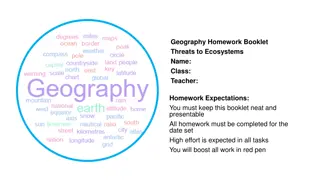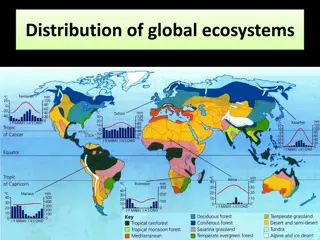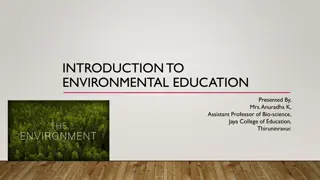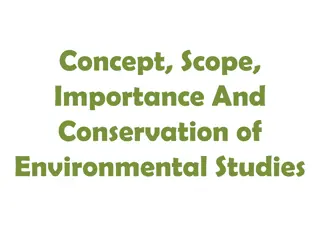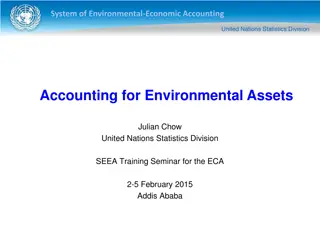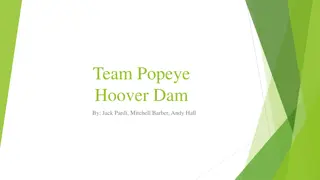The Importance of Environmental Protection in Ecosystems
Nature's beauty and vitality are highlighted in the ecosystems, emphasizing the urgency of protecting the environment. The content focuses on pre-tests, activities, and objectives related to environmental protection, outlining ways to safeguard our planet from harmful consequences of human actions.
Download Presentation

Please find below an Image/Link to download the presentation.
The content on the website is provided AS IS for your information and personal use only. It may not be sold, licensed, or shared on other websites without obtaining consent from the author. Download presentation by click this link. If you encounter any issues during the download, it is possible that the publisher has removed the file from their server.
E N D
Presentation Transcript
Ecosystems Environmental Protection
Navigation Table Ecosystems: Environmental Protection Pre-Test Introduction Why It Matters How We Know What We Know Story Time Activities Self-Study Game Post-Test Glossary
Environmental Protection Pre-Test Ecosystems: Environmental Protection Pre-Test Introduction Click a link below to take the pre-test for this unit! Why It Matters Google assessment How We Know What We Know Story Time Activities Self-Study Game Post-Test Glossary
Environmental Protection Ecosystems: Environmental Protection Pre-Test Introduction Why It Matters Introduction How We Know What We Know Story Time Activities Self-Study Game Post-Test Glossary
Introduction Environmental Protection Ecosystems: Environmental Protection Nature is beautiful and marvelous to behold. Pre-Test Introduction Why It Matters How We Know What We Know Story Time Humans need to protect the environment. Activities Self-Study Game Post-Test Glossary
Environmental Protection Objectives Ecosystems: Environmental Protection Pre-Test Introduction After completing this lesson, each student should be able to: Why It Matters Explain the benefits of protecting the environment How We Know Provide examples of how humans damage the environment What We Know Suggest things that humans can do to protect the environment Story Time Explain how our good intentions for the environment can have unintended bad consequences Activities Self-Study Game Post-Test Glossary
Environmental Protection Ecosystems: Environmental Protection Pre-Test Introduction Why It Matters Why It Matters How We Know What We Know Story Time Activities Self-Study Game Post-Test Glossary
Why It Matters Environmental Protection Why Do We Have to Protect the Environment? Ecosystems: Environmental Protection Pre-Test We can read it in the headlines daily, "The health of ecosystems on which we and all other species depend is deteriorating more rapidly than ever," stated Robert Watson as part of a United Nations report on the environment. What are we doing wrong? Mostly the problem is destruction of habitat by: industrial pollution Introduction Why It Matters How We Know What We Know mining farming Story Time transporting species into habitats where they had not been Activities Self-Study Game Post-Test Glossary
Why It Matters Environmental Protection Why Do We Have to Protect the Environment? Cont d Ecosystems: Environmental Protection What are some of the consequences? Worldwide, 780 million people do not have access to an improved water source Pre-Test Introduction Two and a half billion people lack access to improved sanitation Why It Matters More than 90% of the world s population (mostly in large cities of newly industrialized countries) breath air that is dangerously unhealthy How We Know What We Know Hundreds of millions of poor farmers struggle to make a living on poor land Story Time Whole countries are on the verge of famine Activities It is important to care about the environment. Thoughtful people can care about the environment and at the same time see the need to use nature for resources to satisfy the needs of our species. Self-Study Game Post-Test Glossary
Why It Matters Environmental Protection Why Do We Have to Protect the Environment? Cont d Ecosystems: Environmental Protection Pre-Test The human species needs food and water. We need energy. But we also need to protect the ecosystem niches that make survival of our species possible. Beyond that, we need to protect the niches for other species too. Why do niches need protection? 1. It's not nice to try to fool Mother Nature. Ecosystems are complicated. We have seen in these lessons that complexity grows as we move up the ladder from cells to organ systems to ecosystems. The history of our attempts to manipulate ecosystems shows that we often make mistakes and fail to see the unintended consequences of our actions. Rich ecosystems are those with many occupied niches. A change in any one niche is likely to affect other niches and their occupant species. Extinction is forever. We don't get a second chance. Introduction Why It Matters How We Know What We Know Story Time Activities Self-Study Game Post-Test Glossary
Why It Matters Environmental Protection Why Do We Have to Protect the Environment? Cont d 2. Environmental hazards are dangerous. Our lakes and oceans have become dumping grounds for dangerous chemicals (pesticides, herbicides, oil and refinery products, industrial wastes, and heavy metals). Some of these toxins concentrate in food webs, such as mercury in fish. Ecosystems: Environmental Protection Pre-Test Introduction Why It Matters How We Know What We Know Story Time Activities Self-Study Game When large tracts of land are plowed, the exposed soil can erode during rainstorms. Much of this runoff flows to the sea, carrying with it agricultural fertilizers and pesticides. Source: NOAA Post-Test Glossary
Why It Matters Environmental Protection Why Do We Have to Protect the Environment? Cont d Ecosystems: Environmental Protection Pre-Test 3. Moral Obligation. Our species owes its existence to the living world that we share with other species. We owe the living world a chance to perpetuate the life-creating processes of natural selection, population dynamics, and exchange cycles. We can only pay this debt by protecting the environment Introduction Why It Matters How We Know We humans are doing well as a species (see graph on next slide). But our success comes at the expense of other species. The United Nations Intergovernmental Science- Policy Platform on Biodiversity and Ecosystem Services (IPBES) warns that up to 1 million species are threatened with extinction, many within decades. Over 40% of amphibian species are threatened with extinction. What We Know Story Time Activities Self-Study Game Post-Test Glossary
Why It Matters Environmental Protection Environmentalism and Politics Many people in the world like to blame industrialized nations, especially the United States, for destroying world ecosystems. It is true that industrialized countries create much of the air pollution. But the problem will not be cured by treaties that punish American companies for air pollution when competing companies in other countries are exempt from regulation. World population is now over 7.5 billion. Over a 100- years, the world population has more than tripled and the growth seems to be continuing at an increasing rate. How long can the human species sustain such growth? Ecosystems: Environmental Protection Pre-Test Introduction Why It Matters How We Know What We Know Story Time Activities Self-Study Game Post-Test Glossary
Why It Matters Environmental Protection Environmentalism and Politics Cont d The really frightening prospect is the rapid pace of industrialization in many Third World countries where unregulated industries expand to serve the growth of the already huge populations. China and India each has more than 1.3 billion people. What will world pollution be like when countries like these become fully industrialized and modernized? People who wish to protect the environment often become politically active. They may come to believe that animals, and even plants, have "rights." What do you think? The idea of "rights" originally came from perceived inequalities in power and privilege among humans. "Rights" are something we United States citizens have to pursue "life, liberty, and happiness. Ecosystems: Environmental Protection Pre-Test Introduction Why It Matters How We Know What We Know To extend the idea of rights across species quickly creates problems for ecosystems. Does the wolf have a right to kill sheep? Or do sheep have a right to be protected from predators? Does any species have a right to use Nature's resources to perpetuate itself as a species? Does a species have a right to destroy niches of other species in the process of exploiting nature for survival of the species? And if we could agree on any of these rights, we must answer the question, "Who issued these rights?" Story Time Activities Self-Study Game Post-Test Glossary
Why It Matters Environmental Protection Environmentalism and Politics Cont d Ecosystems: Environmental Protection Pre-Test Introduction To argue in the political terms of "rights" misses the point about how Nature's ecosystems work. Competition between and within species is not only natural but necessary for ecosystems to function well. Competition and exercise of power becomes a problem only when it is so destructive that an ecosystem itself becomes threatened. Because humans have the greatest power to damage ecosystems, humans also have the greatest duty to protect ecosystems. Why It Matters How We Know What We Know Story Time Activities Self-Study Game Post-Test Glossary
Why It Matters Environmental Protection Species Become Extinct. So What? When a species becomes extinct, it no longer has any known living individuals. A species arises only under a unique situation in which there is a great deal of genetic diversity in a population that matches the opportunities provided by a unique and currently unoccupied niche. How sad it is to learn that humans are driving so many species toward extinction. Humans even deliberately kill (hunt) such marvelous animals as elephants, rhinos, and gorillas. Click here or here to see how students can get involved in conserving wildlife. Ecosystems: Environmental Protection Pre-Test Introduction Why It Matters How We Know What We Know Story Time Activities Self-Study Game Post-Test Hunters in Africa kill elephants just to get their ivory tusks. Glossary
Why It Matters Environmental Protection Species Become Extinct. So What? Cont d Ecosystems: Environmental Protection Pre-Test Appearance of new species depends critically on diversity of genes and diversity of niches. But human activity is producing the opposite at alarming rates. We eliminate many niches by creating habitats suitable for our species (example: we wipe out a forest to build a housing development). We drive into extinction plant and animal species at a rate of about one species per day. The unique genes of these extinct plants and animals are lost forever. Our selective breeding of plants and animals creates uniformity in gene pools. Evolution of new species, which has usually taken thousands or millions of years, will proceed at even slower rates. There is no way that the pace of new species can keep up with the rate of extinction. Introduction Why It Matters How We Know What We Know Story Time Activities Self-Study Game Post-Test Glossary
Why It Matters Environmental Protection Species Become Extinct. So What? Cont d So, does it matter, in the short term of human existence thus far, that humans reduce genetic variation in plants and animals and drive so many species into extinction? How would you defend a position that it does matter? Think in terms of: Do we devalue life by destroying it? Ecosystems: Environmental Protection Pre-Test Introduction Why It Matters Do we change the course of future medicine by making gene pools of plants and animals more uniform? How We Know What We Know Forest and jungle plants can be sources of new medicines. Fanny Payaguaje, medicinal plant garden curator in the Amazon, guides a group of school children through the medicinal plant garden and points out a common, red- berry weed used to treat skin funguses one of the most common ailments for children in this moist, tropical rainforest. From: https://www.amazonfrontlines.org/chro nicles/indigenous-youth-knowledge/ Story Time Activities Self-Study Game Post-Test Glossary
Why It Matters Environmental Protection Why Humans Are the Ecological Problem Ecosystems: Environmental Protection Human population growth increases the demand for food, water, and energy. At some point, the world population must reach the earth's maximum capacity to support the species. At that point, a remedy will be imposed in one or more of the following forms: starvation Pre-Test Introduction Why It Matters mass epidemic How We Know war What We Know All of these possibilities are ugly. Unfortunately, starvation, epidemics, and war have already started in many parts of the world. All three are common in certain parts of Africa. The demand of humans for more food, more water, and more energy not only threatens the human species, but it also devastates ecosystems in which other species lives. Story Time Activities Self-Study Game Post-Test Glossary
Why It Matters Environmental Protection Why Humans Are the Ecological Problem Cont d Ecosystems: Environmental Protection Consider agriculture. Clearing jungles to create pastures changes a rich ecosystem that can support hundreds of species into an impoverished one that supports only a few species. The solution, according to Dr. Norman Borlaug, the "Father of the Green Revolution," is not to destroy more forests and jungles to create more farm land. The solution is to make the land we currently use for farming even more productive. The "Green Revolution" is well underway in Third World countries where agricultural productivity is being improved by better strains of plants and animals, and selective use of fertilizer, herbicides, and pesticides. Modern agricultural practices not only provide more food, but by doing so without using more land, they produce a dramatic conservation effect. To read more about Dr. Norman Borlaug, click here. Pre-Test Introduction Why It Matters How We Know What We Know Story Time Activities Self-Study Game Click here for the United Nations Web site on world-wide agriculture. Post-Test Glossary
Why It Matters Environmental Protection Why Humans Are the Ecological Problem Cont d Political problems are preventing completion of the Green Revolution. Many environmentalists object to the use of pesticides and herbicides (and some even object to fertilizer). Ecosystems: Environmental Protection Pre-Test Introduction Local small farm owners typically do not have the knowledge or expertise to use more productive farming practices. In Mexico, Profepa, the federal agency charged with protecting Mexico s natural resources, estimates that the country loses about 1.3 million acres of forests each year, the fifth worst deforestation rate in the world. Most of this deforested land is used to expand poorly productive local farms and for grazing for cattle. Why It Matters How We Know What We Know Story Time Many people object to genetic engineering, which could create many strains of plants and animals that are both disease resistant and grow more efficiently. Activities Self-Study Game The adding of more people by increasing population growth makes demands on resources and causes the production of more pollution. Post-Test Glossary
Why It Matters Environmental Protection Why Humans Are the Ecological Problem Cont d Some environmentalists say that low-yield farming is more "sustainable." But Borlaug says that Africa proves that low-yield farming is sustainable only in the face of higher death rates. In many parts of Mexico, local farmers farm in the same inefficient way that their Mayan ancestors did 2000 years ago. The problem of too many people with too little food is made worse by population growth. Small local farmers around the world are caught in a downward spiral of trying to have bigger inefficient farms and they destroy the jungle and forests in the process. Ecosystems: Environmental Protection Pre-Test Introduction Why It Matters Are humans smart enough to save themselves and their environment? Maybe human evolution is not yet finished. How We Know What We Know Simnai and Phillip Tshuma, smallholder farmers from Hwange, Zimbabwe, show off their sorghum crop planted using fertilizers. Photo: Busani Bafana Retrieved from: United Nations Story Time Activities Self-Study Game Post-Test Glossary
Environmental Protection Ecosystems: Environmental Protection Pre-Test Introduction Why It Matters How We Know How We Know What We Know Story Time Activities Self-Study Game Post-Test Glossary
How We Know Environmental Protection Ecosystems: Environmental Protection We can know how safe our environment is if we monitor it: measure the amount of toxins and other pollutants in our air, water, and soil. This works, but we have to know which specific chemicals to monitor. This is not always possible. Sometimes, we rely on biological monitors. Ever hear of canaries in the coal mines? Canaries can act as an early warning signal. They would die from toxic chemicals at much lower concentrations than would humans. More recently, frogs are attracting attention as sentinels. For example, male frog sexual development is impaired by a weed killer (atrazine) at 1/30th of the level thought to be safe for people. In the past decade, 200 frog species have declined and 20 are thought to have become extinct. But some things are obvious, right? Most people would agree that we probably ought to clean up dirty air, dirty water, radioactive wastes, and other such obvious sources of environmental hazards. Nor is there much debate over such ecology-damaging events as soil erosion and chopping down forests and jungle. A little common sense can help us know when we are not protecting the environment. Here are some issues that may not be so obvious: Pre-Test Introduction Why It Matters How We Know What We Know Story Time Activities Self-Study Game Post-Test Glossary
How We Know Environmental Protection Ecosystems: Environmental Protection Fertilizer Run-off Fertilizer that runs off into ponds and lakes creates an environmental problem. Do you know why? If you look at ponds and lakes that drain heavily fertilized farm fields, what do you suppose you would see? You would see that the water was greenish (like pea soup) or brown, that there was much plant growth in it. If you looked at water samples under the microscope, you would see many single-celled organisms and a wide range of insects and other invertebrates. These organisms fix the nitrogen from the fertilizer. However, most plants cannot use this nitrogen and excess nitrogen in the environment limits species diversity. In our Water s the Matter Module, there is a unit on measuring nitrates and effects on water quality. Many fertilizers also contain toxic chemicals than can accumulate in the environment. Pre-Test Introduction Why It Matters How We Know Toxic algae bloom in Florida was linked to fertilizer runoff. Click here for more. Picture: Richard Graulich/The Palm Beach Post What We Know Story Time Activities Self-Study Game Post-Test Glossary
How We Know Environmental Protection Ecosystems: Environmental Protection Antibiotic Resistance How do we know if a given bacterium has developed resistance to an antibiotic? The original technique was to collect a sample of the bacterium. For example, if you have a sore throat, the doctor might swab the back of your throat and send that swab to a laboratory. A laboratory technician would gently rub the swab on some growth medium in a round glass dish and place little disks containing antibiotic on top of the growth medium. When the glass dish is placed in a warm oven for a day or so, the bacteria will grow all over the growth medium, EXCEPT near the disks that contain antibiotic that kills the bacteria. There will be a clear zone, a halo, around each disk that has the kind of antibiotic in it that prevents bacterial growth. In recent years, this technique is showing that more and more kinds of antibiotics have lost their effectiveness. Pre-Test Introduction Why It Matters How We Know What We Know On this agar plate, a strain of bacteria is tested for resistance to each of twelve different antibiotics. A clear zone around a disc of the antibiotic indicate that the bacteria in the dish is unable to survive in the presence of the test antibiotic. Source Story Time Activities Self-Study Game Post-Test Glossary
How We Know Environmental Protection Ecosystems: Environmental Protection Poor Farming Practices What do you suppose will happen if a farmer plants his crops on a hillside? Rains might wash away the soil, right? Elsewhere, we showed you a picture of the Mississippi River and all the dirt that it contained. Where do you suppose that dirt came from originally? When rivers flood, the dirt they carry settles out and helps to enrich the fields. Much of that good soil is carried in streams and rivers and does not settle out until reaching the ocean. Pre-Test Introduction Why It Matters How We Know Smoke billows from fires in the Yucatan. Source: NASA What We Know A winding river with deposits along its banks. Story Time What do you suppose would happen if you grew crops year after year and burned off the field instead of plowing it under? What happens to dead plant matter? Do you know that it helps the soil hold moisture? Plowing crops and keeping the dead plant matter decreases the soil erosion problem and also decreases the need for as much water. Activities Self-Study Game Post-Test Glossary
How We Know Environmental Protection Ecosystems: Environmental Protection Running Out of Oil? How do we know how much oil there is in the world? We do not know for certain. We can, however, make estimates. These estimates are based on: The amount of oil coming out of wells and the rate at which the production declines over time Pre-Test Introduction Why It Matters The size of new potential fields (as in Alaska) where wells have not yet been drilled. You could estimate oil fields by making small drill holes to sample it. However, boreholes yield very narrow samples and may drill right past substantial deposits of oil. Size of a potential oil field is best determined by blasting sound waves into the soil and recording the echo. Oil beneath the surface will reflect sound waves differently from echoes from rock. Complex computer analysis of the echo data in three dimensions provides an estimate of the three- dimensional size of pools of oil beneath the surface. This technique is known as three-dimensional seismography. How We Know What We Know Story Time Activities Self-Study Game Post-Test Glossary
How We Know Environmental Protection Ecosystems: Environmental Protection Running Out of Oil? Cont d We know we are running out of oil, but estimates of the time left vary enormously. Regardless of how much time we have left, we need to find new sources of energy. We need to do that now, even if we have enough oil, so that we can stop polluting our air and water with car exhaust and gasoline refinery wastes. As for preventing oil spills in our lakes and oceans, we know how to do that just from observing how oil spills in the past have occurred. We just need to: Replace old, leaky pipelines Pre-Test Introduction Why It Matters How We Know What We Know Avoid human errors in handling of oil cargo Prevent accidents of tankers and barges Story Time Activities Prevent leaks and spills from offshore drilling rigs Self-Study Game A controlled in-situ burn of surface oil after the 2010 Deepwater Horizon/BP spill in the Gulf of Mexico. (USCG) Retrieved from: NOAA Post-Test Glossary
How We Know Environmental Protection Ecosystems: Environmental Protection Forest Management When old trees are not harvested, a large growth of small brush creates fuel during droughts. Much debate occurs over how to manage forests, because it is not always clear how we know which practices work. You can't run controlled experiments, where one plot of hundreds of acres is managed one way and another plot is managed another way. You can't control the climate so that both plots get the same amount of rain, have the same growth of underbrush, or have the same wind conditions. Pre-Test Introduction Why It Matters How We Know So, we are left with common sense. Here is a partial list of things to consider: If you chop down all the trees, replanting young ones might not work if rains wash away the soil. What We Know Story Time If you don't allow any trees to be harvested, a lot of underbrush will grow and create a huge fuel source when lightning (or a camper) creates a forest fire. Activities Self-Study Game If you prohibit roads being built into forests, you keep the campers out and reduce the chances that they will accidentally cause a fire. Post-Test Prohibiting roads will not stop lightning from causing fires and it makes it harder for fire fighters to control a fire. Glossary
How We Know Environmental Protection Ecosystems: Environmental Protection Overfishing If too many fish (or lobsters or other sea life) are harvested, at first there might not be any sign of harm. Eventually, however, the yield of harvest will decrease and get less and less. The only way to know whether a fish population is declining is to actually count them. Because many species migrate, you have to do counts at various times of the year. Scuba divers often volunteer to perform such fish counts. Click here to learn how scuba divers conduct the counts. If you stop fishing, the reefs may become re-populated quickly. As the reef habitat is vacated, the empty niches attract other animals from adjacent areas to move in. There is a risk of extinction of many species. By decreasing the population, you reduce the chances for successful reproduction, and the problem might get so bad that you drive the overfished species into extinction. Think of it like eating seed corn. If you ate all the seed, there would be no way to plant a new crop. Pre-Test Introduction Why It Matters How We Know What We Know Story Time Activities So, the obvious solution is to restrict harvesting - by law if necessary. This is a major effort in all state fish and game agencies. Click here for a listing of state fish and game agencies throughout the U.S. Self-Study Game Post-Test Glossary
Environmental Protection Ecosystems: Environmental Protection Pre-Test Introduction Why It Matters What We Know How We Know What We Know Story Time Activities Self-Study Game Post-Test Glossary
What We Know Environmental Protection Sharing the Love? Ecosystems: Environmental Protection Humans change the environment in many ways, both accidental and deliberate: We put chemicals into the soil, water, and air Pre-Test We chop down jungles and forests Introduction Likewise, humans move animals around and introduce them into niches they would not have encountered on their own. Ever since the intercontinental travel began by sea several hundred years ago, humans have been re-distributing plant and animal life. Why It Matters How We Know Source: GPS.gov Creatures stow away in cargo or on the vessels or vehicles. Rats and cockroaches, for example, have overrun the entire planet, thanks to easy access to these means of transportation. What We Know Story Time Activities Bacteria and virus move with the animals and people that move about. A disease that pops up anywhere in the world will eventually spread everywhere. Recent examples include AIDS and West Nile fever. Self-Study Game Post-Test Source: NOAA Glossary
What We Know Environmental Protection Sharing the Love? Deliberate introduction of species into new environments can lead to unintended consequences. These non-native organisms are called invasive species. Examples include: Ecosystems: Environmental Protection Pre-Test House sparrows, introduced into U.S. in 1850, now number in the hundreds of millions and have crowded out many bird species. Introduction Rabbits, introduced into Australia in 1859, thrived so well that they ate all the grass down to the roots and killed shrubs and bushes by eating all the bark. An estimated population of 750 million rabbits ate as much grass as would have been eaten by 100 million sheep. A viral disease that would kill rabbits was introduced around 1950. At first, 98% of rabbits were killed, but the survivors became resistant. Today, their descendants are only about 25% susceptible. Why It Matters How We Know What We Know Sheep and cattle have displaced countless communities of plants and animals that could otherwise occupy the vast spaces that cattle and sheep require. Story Time Agricultural crops (corn, wheat, etc.) destroy the niches that could support a wide range of native species. Activities We are rapidly becoming one homogenous world. In the process, we must be careful about upsetting the balance of nature. In the book, Rogue Primate, author John Livingston says that "Nature thrives on diversity and variety. Anything that tends to reduce the normal complexity of interrelationships is biologically destructive." Self-Study Game Post-Test Glossary
What We Know Environmental Protection Animal Destruction of the Environment-Example When Charles Darwin first encountered Galapagos Island, it was like a Garden of Eden, full of lush vegetation and a huge range of animal and plant species. Each species had specific physical features that made it capable of operating within its specific niche. For example, birds that cracked nuts for food had large, tough jaws and beaks. Birds that ate other kinds of food had beaks that were specialized for that kind of food. Ecosystems: Environmental Protection Satellite view of one of the Galapagos Islands, located 1200 kilometers West of Ecuador. This island has six active volcanoes. Courtesy of NASA. Pre-Test Introduction Why It Matters How We Know A few goats had been set loose by sailors in the hope that their offspring would provide food for ship personnel in the future. Today, goats have taken over the islands. Some of the islands are now stripped of vegetation. Before the arrival of goats, the islands had no plant-eating mammals except turtles and iguanas that had low metabolism and ate little. Where goats have stripped everything, turtles and iguanas now face extinction. They don't eat much, but some vegetation is still essential for their survival. Turtles are also under attack from other human-introduced creatures: rats, dogs, and pigs dig up turtle eggs to eat. Iguanas are eaten by dogs and pigs. What We Know Story Time Activities Self-Study Game How sad it is to see this devastation of this living museum of evolution. Post-Test Glossary
What We Know Environmental Protection Humans Are the Big Environmental Problem We humans like to think of ourselves as superior to other species. We can do things with our brains that no other species can. This attitude of superiority has been called "speciesism." By what standards do we measure the superiority of a species? Do we mean the ability create powerful tools and procedures that can even change the ecological niche in which a species lives? By that measure, humans are clearly superior to all species. Ecosystems: Environmental Protection Pre-Test Introduction Why It Matters Do we mean the total number of similar species? The fossil record has revealed no more than about a half-dozen human-like species. All have become extinct, except one (our species). Meanwhile, bacteria and insect species number in the millions and have thrived for millions of years. Do we mean the fitness to adapt to Nature's niches and thrive as a species? By that measure, humans fail to impress. Humans kill each other by the millions -- in war and with diseases, such as AIDs. The modern human species may be no more than 1/2 million years old, while bacterial fossils have been found that are 3.5 billion years old. How We Know What We Know Story Time Activities Self-Study Game Post-Test Glossary
What We Know Environmental Protection Humans Are the Big Environmental Problem Cont d Humans are not immune to extinction. As the earth's population grows to the point where we have exhausted our resources or become so overcrowded as to encourage devastating plagues or wars, extinction becomes possible. More certain is that bacteria and bugs will be around long after we are gone. Ecosystems: Environmental Protection Pre-Test Introduction Why It Matters We humans dominate the earth and the other living things in it. We exploit Nature to satisfy our desires. We whitewash our excessive desires by defining them as rights. We selfishly decide that our rights come first ahead of those of other species that have no rights. This viewpoint is then used to justify our abuse of the environment and the damage that we do to other species. How We Know What We Know Story Time Have you heard of "rogue elephants," which are elephants that run amok, causing devastation everywhere they go? Author John Livingston has called humans the "Rogue Primate." Is that what we have become? Activities Self-Study Game Post-Test Glossary
What We Know Environmental Protection Too Much of a Good Thing: Over-fertilization Ecosystems: Environmental Protection Pre-Test Chemical fertilizers contain mostly nitrogen, phosphorous, and potassium. They are used on crops because they make crops grow better. Indeed, new genetic strains of crops were developed because they could grow better if given extra fertilizer that is not normally present in most soils. The "Green Revolution" has saved millions of people from starvation because fertilization of genetically improved plants has allowed us to increase food production in order to keep up with the demands of the rapid growth in human population to 7.5 billion people. The argument has been made that we should do even more fertilization, so that we can grow more food on the same amount of land and thus stop clearing of forests and farming on land that is subject to washing away when it rains. Introduction Why It Matters How We Know What We Know Story Time Activities Self-Study Game Post-Test Glossary
What We Know Environmental Protection Too Much of a Good Thing: Over-fertilization Cont d But what happens to extra fertilizer that is not taken up by plants? For example, fertilizer can be washed away in the runoff when it rains. Where does this water go? It flows into creeks, ponds, rivers, and lakes. What happens then? The plant life in the water explodes, especially in response to the nitrogen in fertilizer. So why is that a problem? For one thing, it can choke the waterway so that fish and other animal life can no longer live there. Ecosystems: Environmental Protection Pre-Test Introduction Why It Matters How We Know Too much nitrogen and phosphorus in the water can have diverse and far-reaching impacts on public health, the environment and the economy. Photo credit: Bill Yates. What We Know Green algae, water lilies, and sea "weeds" can grow so fast that they cannot rot as fast as they die. The decay of this massive growth robs the water of oxygen, so fish cannot live. Ponds and lakes can become really stinky. The overgrowth robs other living things in the water of light and nutrients. It changes the niches and breeding grounds for other species and typically drives them out. Click here to see examples of these problems. Story Time Activities Self-Study Game We should also mention that fossil fuels are used to make fertilizers, and we are already running out of fossil fuels. Extra growth of plants also makes demands for more water. This is a real problem when farmland has to be irrigated. There may not be enough water to go around. Post-Test Glossary
What We Know Environmental Protection Too Much of a Good Thing: Antibiotic Use Have you ever had a doctor prescribe antibiotics? Did the doctor tell you to make certain that you skip no doses and continue taking the medicine until all pills are taken? Why do you suppose this is? If you stopped taking an antibiotic as soon as you felt better, would there still be some bacteria alive? Which ones would be most likely to have survived up to this point? the ones that had so far resisted the antibiotic. In other words, you could be creating a population of bacteria in your body that had developed resistance to the antibiotic. Ecosystems: Environmental Protection Pre-Test Introduction Why It Matters How We Know What We Know What would happen if you took the same antibiotic all the time, that is, every time you got a cold or felt bad. A few bacteria would survive, and at some point, they might even start to thrive in the presence of the antibiotic. The constant exposure to the same antibiotic would become a natural selection force that could select the creation of a new species or strain of bacteria that is resistant to that antibiotic. Now when you get sick again with these resistant bacteria, your antibiotic will no longer work. Story Time Activities Self-Study Game Post-Test Glossary
What We Know Environmental Protection Too Much of a Good Thing : Antibiotic Use Cont d Ecosystems: Environmental Protection This is exactly what has happened with penicillin. Penicillin, the first antibiotic, was discovered in the 1940s and was very effective against many kinds of bacteria. Now, because of overuse of antibiotics, many of these bacterial strains are no longer affected by penicillin. Pre-Test Introduction Why It Matters How We Know What We Know Story Time Activities Structure of penicillin. Source: PubChem The same problem has developed with several other antibiotics. The more popular and widely used an antibiotic is, the more likely it will lead to resistant strains of bacteria. Eventually, we may run out of effective antibiotics. Then what? Self-Study Game Post-Test Glossary
What We Know Environmental Protection Depletion of Natural Resources: Poor Farming Practices Mayan farming. Ancient Mayans in Central America (from about 0 to 900 AD) had a "slash and burn" method of farming. Each year after the harvest, they would cut down all the old plants and set the fields afire. Then they would repeat the process again the next year on the same plot of ground. After about 7 years, the soil was so depleted of nutrients and organic matter that it had to be abandoned. They moved on to clear another patch of ground. The Mayan population grew, sometimes to include cities with a hundred thousand or more people. Soon, the farmers could not grow enough food and there was no more good soil. Then the farmers started farming marginal land, such as hillsides. That created other problems, because the hillsides were easily eroded by rain. We may never know all the reasons why the Mayan civilization disappeared, more or less suddenly around 900 AD. Two things are clear: 1) people abandoned the cities and returned to simpler living, and 2) massive farming efforts could no longer be sustained. Ecosystems: Environmental Protection Pre-Test Introduction Why It Matters How We Know What We Know Burning crop land (here in Brazil) depletes the soil and exposes it to wind and rain erosion. Photo Ueslei Marcelino/Reuters Story Time Activities Self-Study Game Post-Test Glossary
What We Know Environmental Protection Depletion of Natural Resources: Poor Farming Practices Cont d Oklahoma Dust Bowl. In the 1930s in the U.S., most of Oklahoma and much of West Texas turned into a dust bowl because of a drought. Trees were cut down and grassland was turned into crop land. The soil then became exposed to erosion from rain and wind. When drought came, the land became worthless, unable to grow anything. The air was choked with dust. Many farmers had to abandon the land and move to other states, such as California. Click here to read the story of the Dust Bowl. Ecosystems: Environmental Protection Pre-Test Introduction Why It Matters How We Know What We Know Story Time Activities Self-Study Game Post-Test Dust cloud rolling over western Kansas town, February 21, 1935 Glossary
What We Know Environmental Protection Depletion of Natural Resources: Over-fishing People who live on islands are very dependent on the fish life around them. As an island becomes more populated with people, the demand for food from the sea can outstrip the source. This has happened recently on the islands off the coast of Honduras. The people there are very poor. Their struggles were only made worse when they depleted the fish and sea creatures. Such problems were made even worse when a seafood restaurant chain set up a factory there for processing lobster and fish. It didn't take long to exhaust the sea's supply. Ecosystems: Environmental Protection Pre-Test Introduction Why It Matters How We Know What We Know Story Time Activities Self-Study Game Post-Test Coral reefs shelter and feed many fish. Where did all the fish go? Glossary
What We Know Environmental Protection Depletion of Natural Resources: Over-fishing Cont d Ecosystems: Environmental Protection Pre-Test Introduction Over-fishing not only threatens the human food supply but also that of other species that feed on sea life. One example of a species threatened in this way is the Russian Brown bear. One hopeful sign is fish hatcheries, where fish are raised in captivity. For more on the world crisis in over-fishing, click here. Why It Matters How We Know What We Know Story Time Activities Self-Study Game Post-Test Glossary
What We Know Environmental Protection Oil Depletion Ecosystems: Environmental Protection Do you know where gasoline comes from? It comes from processing oil. Where does most of the world's oil come from? The oil that we pump out of the ground today took millions of years to make. So our oil supplies are not renewable -- once gone, gone forever. An oil shortage is inevitable. Some analysts think that shortages may develop, even as soon as in the next few years. Then what? Prices will go up. Oil and gas may get so scarce that people start wars. What can we do? One option is to drill more wells. One problem is that oil wells create hazards to wildlife if there are spills from tankers or breaks in pipelines. On the other hand, if new wells only maintain our current supplies, no additional hazards are created. Pre-Test Introduction Why It Matters How We Know What We Know Story Time Activities Self-Study Game Post-Test Glossary
What We Know Environmental Protection Oil Depletion Cont d Many people are trying to stop all new drilling, especially in wildlife areas such as Arctic National Wildlife Refuge (ANWR) in Alaska. Others argue that we cannot develop alternatives to gasoline fast enough and that there are responsible ways to drill for oil in wildlife areas (click here to see their arguments). These debates influence our national energy policy and laws passed by Congress. Ecosystems: Environmental Protection Pre-Test Introduction Why It Matters How We Know What We Know Story Time Activities Arctic National Wildlife Refuge in Alaska Source: U.S. FWS Self-Study Game So, what to do? Of course, we should do the research needed to develop other sources of energy. In the meanwhile, we must get new sources of oil. And in the process, we must be careful not to add a burden on the environment. Post-Test Glossary
What We Know Environmental Protection Success Stories Environmental Hazards Can be Eliminated: Unleaded Gasoline For about 80 years, lead was used as an additive in gasoline to make car engines run smoother. It became the primary source of lead pollution in the United States. Lead poisoning causes serious effects, especially on the brains of babies and young children. See our Hazards discussion of lead. In 1990, amendments to the Clean Air Act were enacted to phase out the use of lead in gasoline by the year 1995. Benefits occurred quickly. One study shows that blood-lead levels declined by 80 percent from 1976 to 1999 in American children one to five years old. The European Union has banned the use of lead in gasoline and the World Bank has urged all countries to do so. Since 2002 the Partnership for Clean Fuels and Vehicles, within the United Nations Environment Program has been working to finish the leaded gas phase-out. As of 2017, only six countries continue to use leaded gasoline. Click here for a quick overview of the history of lead use in gasoline. Ecosystems: Environmental Protection Pre-Test Introduction Why It Matters How We Know What We Know Story Time Activities Self-Study Game Post-Test Glossary
What We Know Environmental Protection Success Stories Cont d Endangered Species Can Be Saved In an earlier unit, we talked about how conservation efforts seem to have saved the American Bald Eagle and the Whooping Crane from extinction. There are other modern-day examples of preserving species. Ecosystems: Environmental Protection Pre-Test Introduction For decades, biologists at various institutions in Mexico and Texas have developed programs to save the Kemp s ridley sea turtle species. The Kemp s ridley turtle is the world s most endangered sea turtle. Humans had nearly destroyed the species by harvesting the eggs that the turtles laid on the Gulf Coast beaches. Today, under strict protection, we are cautiously optimistic that the population is on its way to recovery. Click here or here for more information. Why It Matters How We Know What We Know Story Time Activities Source: NPS Self-Study Game Post-Test Glossary
What We Know Environmental Protection Unintended Consequences of Conservation Efforts DDT Example Have you read the Rachel Carson story yet (see Story Time)? Rachel Carson worked at a time when DDT was a common insecticide. Everyone thought it was about the safest bug killer available, and it was used with apparent success for many years. But then people noticed that certain bird species populations were declining. Especially alarming was the U.S. national symbol, the bald eagle. Click here to read about the eagle recovery program. Closer study revealed that bald eagle eggs were cracking and preventing chicks from developing and hatching. Without reproduction, no species can survive. The cause was attributed to DDT, which causes thinning of egg shells. This was an unintended consequence of using the insecticide. And so DDT was banned from use in the U.S. and many countries of the world. Ecosystems: Environmental Protection Pre-Test Introduction Why It Matters How We Know What We Know Story Time Activities A Bald Eagle lands in the top of a tree as a good hunting vantage point. Source: NPS Self-Study Game Post-Test Glossary
